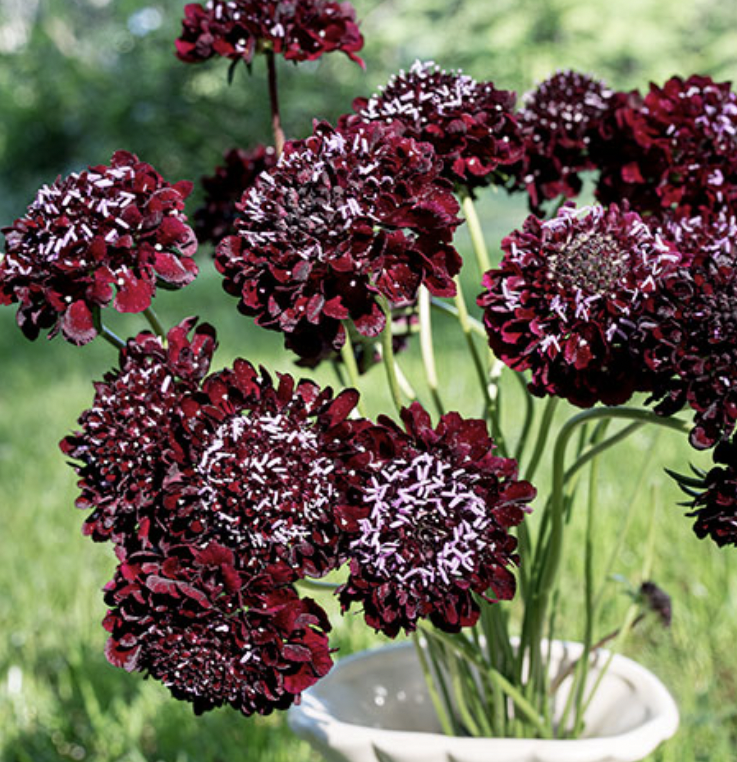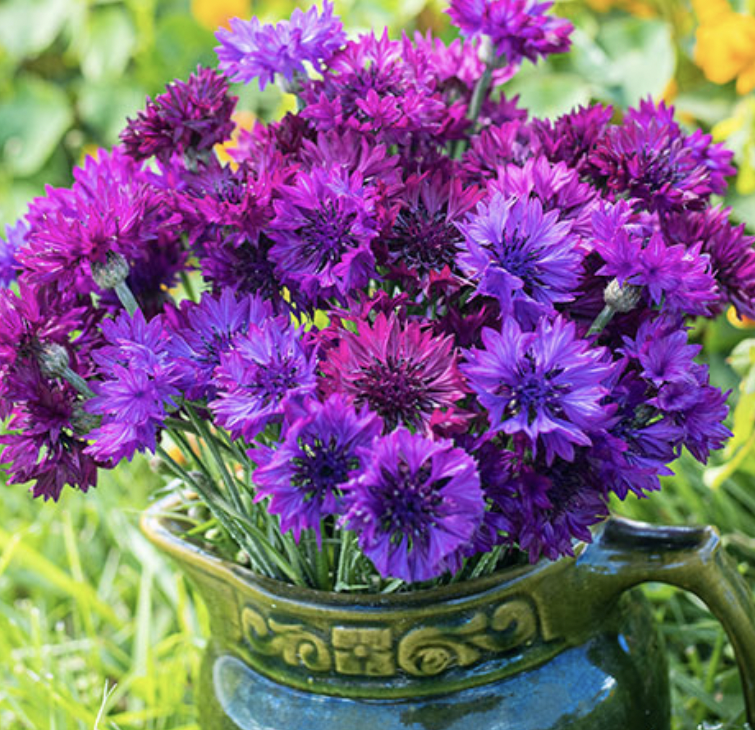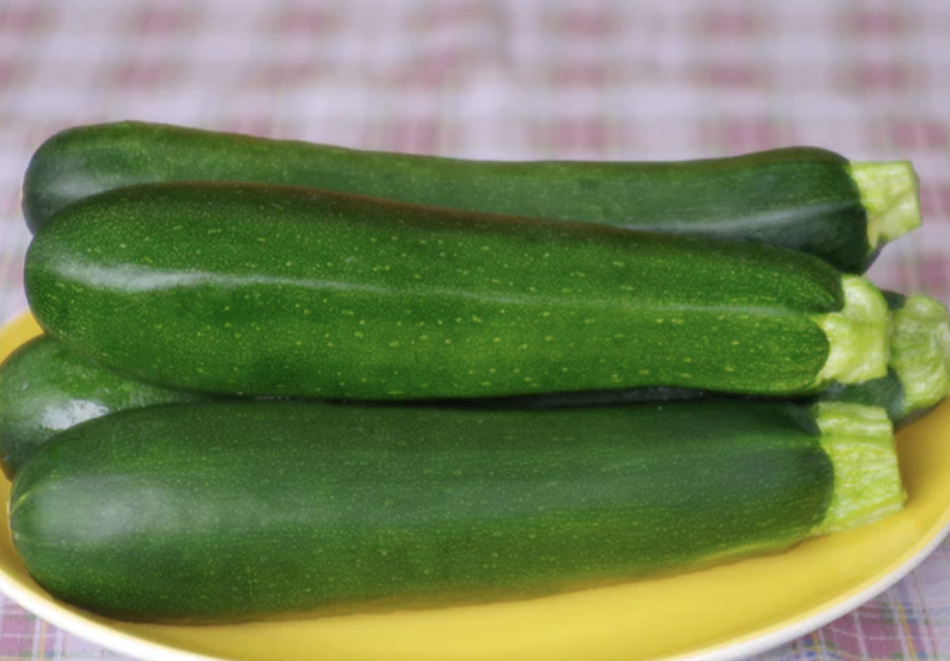Can be used as a cut flower and to attract pollinators to the garden. Annual. Will bloom in the heat of the summer. Can be paired with Scabious Fire King for a fun red-and-black garden theme.
Growing notes:
• Needs 8 + hours of sunlight.
• Performs best in healthy soil.
• Good for a container garden.
Heirloom annual with a bright blue color attracting pollinators. Will self-seed, so it could pop up in your garden in following years. Can be paired with Ultraviolet cornflower.
Growing notes:
• Needs 8 + hours of sunlight.
• Can handle medium-grade soil.
• Great for cutting some buds for a bouquet indoors.
A favorite of pollinators. Great looking in a cottage garden. Can be paired with Emperor William cornflower.
Growing notes:
• Needs 8 + hours of sunlight.
• Can handle medium-grade soil.
• Great for cutting some buds for a bouquet indoors.
SUPER HOT. Seeds from local source who loves hot peppers. New variety to me. Doesn’t taste like chocolate, but has a smokey, sweet flavor besides all the heat.
Growing notes:
• Needs 8 + hours of sunlight and lots of compost.
• May need a stake if it grows too tall.
MILD. Pepper is ready for harvest when it turns from green to brown. Won’t taste like chocolate, the name comes from the color.
Growing notes:
• Needs 8 + hours of sunlight and lots of compost.
• May need a stake if it grows too tall.
A big, red simple tomato for sandwiches and salads.
Growing notes:
• Need 8 + hours of sunlight and lots of compost.
• This is a tall plant, so you’ll need a trellis, cage or stake.
Good flavor and resistant to the cracking that can happen to other tomato varieties. A big slicer of a tomato.
Growing notes:
• Need 8 + hours of sunlight and lots of compost.
• This is a tall plant, so you’ll need a trellis, cage or stake.
Great addition to make salads more interesting. Fresh-picked salad burnet tastes like cucumbers.
Growing notes:
• Perennial.
• Likes partial shade in the spring and more shade in the summer heat.
• Good for a container garden.
A fun frilly kale. Plant about 12 inches apart. Enjoyable raw or cooked.
Growing notes:
• Annual. Will bolt in the heat of the summer.
• Prefers full sunlight and rich soil.
• Good for a container garden.
Chives are often seen gracing a baked potato. Flowers also are edible. Sport a milder taste than many other onions.
Growing notes:
• Perennial. Will grow throughout the year.
• Prefers full sunlight and healthier soil.
• Good for a container garden.
Summer squash variety with some resistance to powdery mildew and mosaic virus — two diseases that easily can take down squash plants in Northeast Georgia.
Growing notes:
• Needs 8 + hours of sunlight and lots of compost.
• Plant at least 2 feet apart from other squash varieties.
• For best pollination, grow two or more squashes varieties.
I am ready to eat all the zucchini. These plants have a slow start, but will produce at a rate deemed unbelievable by new growers. Best to harvest when fruits are in the 8 - 10 inch range.
Growing notes:
• Needs 8 + hours of sunlight and lots of compost.
• Plant at least 2 feet apart from other squash varieties.
• For best pollination, grow two or more squashes varieties.
Classic cucumber, best for eating fresh. Pick when about 8 inches long.
Growing notes:
• Needs 8 + hours of sunlight and lots of compost.
• Will require a trellis, cage or stakes for the vine.
• Plant at least 18 inches apart from other cakes.
Named for its prolific produce fame. Mostly used as a pickling cucumber. Pick when 6 inches long.
Growing notes:
• Needs 8 + hours of sunlight and lots of compost.
• Will require a trellis, cage or stakes for the vine.
• Plant at least 18 inches apart from other cakes.
Tastes sweet — many times they’re my garden snack in the mid-morning. Fun to put in cold leafy salads or roast quickly in the oven for warm salads.
Growing notes:
• Annual. Needs 8 + hours of sunlight, though can tolerate poorer soils better than other tomatoes.
• Needs a trellis or fence to climb on.
• OK to trim this plant to keep it under control, but does produce better when allowed to grow to its heart content.
I’m growing this specifically for making all the salsa verde this summer. These 4-6 ft plants produce small fruits that look like tomatoes, but are wrapped in a husk. Remove the husk to enjoy.
Growing notes:
• Tomatillos need 8 + hours of sunlight and lots of compost.
• This is a tall plant, so you’ll need a trellis, cage or stake.
• One small looking plant can take over a large area in a few weeks, so avoid planting in a small garden or container.
HOT. A favorite in my summer garden, Sugar Rush Peach contains a slightly sweet peachy taste along with a spicy heat. More heat than a jalapeño, less than a habanero, a great choice for salsas with some zing!
Growing notes:
• Needs 8 + hours of sunlight and lots of compost.
• May need a stake if it grows too tall.
• Peach flavor is most noticeable when peppers turn from green to a peachy color.
HOT. This Peruvian cooking pepper is has the lemon-citrus flavor I’ve been looking for! Fruits mature to 2 -3 inches and pack a heat punch greater than a jalapeño, but less than.a habanero.
Growing notes:
• Annual. Needs 8 + hours of sunlight and good soil, preferably amended with compost.
• Plants top out 2-feet, so a good candidate for a container garden.
• Might need some a stake for support, the peppers can weigh down the bush.
A favorite in English, Italian and German cooking, sage is a flavor that’s often associated with roasting meat.
Growing notes:
• Perennial. Cut back in the late fall/winter.
• Can handled poorer soils, but prefers better drainage. If planted in clay soil, make sure it’s on a hill, not a valley.
• Partial shade is fine, but doesn’t grow well in full shade.
• Good for a container garden.
Eat this herb as a pesto, with cheese and crackers, with tomatoes, on pizzas — it’s just one of those essential summer flavors.
Growing notes:
• Annual. Cut back blooms in order to keep the plant producing leaves.
• Can handle poor soil, but does better in quality soil.
• Needs 8 + hours of sunlight.
• Good for a container garden.
Borage leaves have a slight cucumber taste to them and the edible blue flowers can aid in making any salad or cold dish look fancy. Bees love borage flowers, and if you’re looking for a pretty herb that will attract pollinators, this is a good bet.
Growing notes:
• Annual. Transplant borage to its final destination quickly and water well the first few weeks. Once established, the plants are fine, but need attention getting established.
• Plants are top heavy with tons of blooms and if not planted deeply enough will fall over.
• Borage plants are happiest in partial shade.





















Bright red flower that blooms in the heat of the summer. Good for cutting flowers as well as attracting pollinators. Can be paired with Scabious Black Knight for a fun red-and-black garden theme.
Growing notes:
• Needs 8 + hours of sunlight.
• Performs best in healthy soil.
• Good for a container garden.